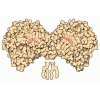登録情報 データベース : PDB / ID : 6ce9タイトル Insulin Receptor ectodomain in complex with two insulin molecules (Insulin receptor) x 2 Insulin A chain Insulin B chain キーワード / 機能・相同性 分子機能 ドメイン・相同性 構成要素
/ / / / / / / / / / / / / / / / / / / / / / / / / / / / / / / / / / / / / / / / / / / / / / / / / / / / / / / / / / / / / / / / / / / / / / / / / / / / / / / / / / / / / / / / / / / / / / / / / / / / / / / / / / / / / / / / / / / / / / / / / / / / / / / / / / / / / / / / / / / / / / / / / / / / / / / / / / / 生物種 Homo sapiens (ヒト)Ovis aries (ヒツジ)手法 / / / 解像度 : 4.3 Å データ登録者 Scapin, G. / Dandey, V.P. / Zhang, Z. / Strickland, C. / Potter, C.S. / Carragher, B. 資金援助 組織 認可番号 国 National Institutes of Health/National Institute of General Medical Sciences (NIH/NIGMS) GM103310 National Institutes of Health/National Institute on Deafness and Other Communication Disorders (NIH/NIDCD) OD019994 Simons Foundation 349247
ジャーナル : Nature / 年 : 2018タイトル : Structure of the insulin receptor-insulin complex by single-particle cryo-EM analysis.著者 : Giovanna Scapin / Venkata P Dandey / Zhening Zhang / Winifred Prosise / Alan Hruza / Theresa Kelly / Todd Mayhood / Corey Strickland / Clinton S Potter / Bridget Carragher / 要旨 : The insulin receptor is a dimeric protein that has a crucial role in controlling glucose homeostasis, regulating lipid, protein and carbohydrate metabolism, and modulating brain neurotransmitter ... The insulin receptor is a dimeric protein that has a crucial role in controlling glucose homeostasis, regulating lipid, protein and carbohydrate metabolism, and modulating brain neurotransmitter levels. Insulin receptor dysfunction has been associated with many diseases, including diabetes, cancer and Alzheimer's disease. The primary sequence of the receptor has been known since the 1980s, and is composed of an extracellular portion (the ectodomain, ECD), a single transmembrane helix and an intracellular tyrosine kinase domain. Binding of insulin to the dimeric ECD triggers auto-phosphorylation of the tyrosine kinase domain and subsequent activation of downstream signalling molecules. Biochemical and mutagenesis data have identified two putative insulin-binding sites, S1 and S2. The structures of insulin bound to an ECD fragment containing S1 and of the apo ectodomain have previously been reported, but details of insulin binding to the full receptor and the signal propagation mechanism are still not understood. Here we report single-particle cryo-electron microscopy reconstructions of the 1:2 (4.3 Å) and 1:1 (7.4 Å) complexes of the insulin receptor ECD dimer with insulin. The symmetrical 4.3 Å structure shows two insulin molecules per dimer, each bound between the leucine-rich subdomain L1 of one monomer and the first fibronectin-like domain (FnIII-1) of the other monomer, and making extensive interactions with the α-subunit C-terminal helix (α-CT helix). The 7.4 Å structure has only one similarly bound insulin per receptor dimer. The structures confirm the binding interactions at S1 and define the full S2 binding site. These insulin receptor states suggest that recruitment of the α-CT helix upon binding of the first insulin changes the relative subdomain orientations and triggers downstream signal propagation. 履歴 登録 2018年2月11日 登録サイト / 処理サイト 改定 1.0 2018年3月14日 Provider / タイプ 改定 1.1 2018年3月21日 Group / カテゴリ / Item / _citation.title改定 1.2 2018年4月18日 Group / Database references / カテゴリ Item _citation.journal_volume / _citation.page_first ... _citation.journal_volume / _citation.page_first / _citation.page_last / _citation.title 改定 1.3 2019年12月18日 Group / Data collection / Otherカテゴリ atom_sites / cell ... atom_sites / cell / chem_comp / pdbx_audit_support Item _atom_sites.fract_transf_matrix[1][1] / _atom_sites.fract_transf_matrix[2][2] ... _atom_sites.fract_transf_matrix[1][1] / _atom_sites.fract_transf_matrix[2][2] / _atom_sites.fract_transf_matrix[3][3] / _cell.Z_PDB / _chem_comp.type / _pdbx_audit_support.funding_organization 改定 2.0 2020年7月29日 Group Advisory / Atomic model ... Advisory / Atomic model / Data collection / Derived calculations / Structure summary カテゴリ atom_site / chem_comp ... atom_site / chem_comp / em_entity_assembly / entity / pdbx_branch_scheme / pdbx_chem_comp_identifier / pdbx_entity_branch / pdbx_entity_branch_descriptor / pdbx_entity_branch_link / pdbx_entity_branch_list / pdbx_entity_nonpoly / pdbx_nonpoly_scheme / pdbx_struct_assembly_gen / pdbx_unobs_or_zero_occ_atoms / struct_asym / struct_conn / struct_site / struct_site_gen Item _atom_site.B_iso_or_equiv / _atom_site.Cartn_x ... _atom_site.B_iso_or_equiv / _atom_site.Cartn_x / _atom_site.Cartn_y / _atom_site.Cartn_z / _atom_site.auth_asym_id / _atom_site.auth_atom_id / _atom_site.auth_comp_id / _atom_site.auth_seq_id / _atom_site.label_asym_id / _atom_site.label_atom_id / _atom_site.label_comp_id / _atom_site.label_entity_id / _atom_site.type_symbol / _chem_comp.name / _chem_comp.type / _em_entity_assembly.entity_id_list / _pdbx_struct_assembly_gen.asym_id_list / _pdbx_unobs_or_zero_occ_atoms.label_asym_id / _struct_conn.pdbx_role / _struct_conn.ptnr1_auth_asym_id / _struct_conn.ptnr1_auth_seq_id / _struct_conn.ptnr1_label_asym_id / _struct_conn.ptnr2_auth_asym_id / _struct_conn.ptnr2_auth_seq_id / _struct_conn.ptnr2_label_asym_id 解説 / Provider / タイプ 改定 2.1 2024年11月13日 Group Data collection / Database references ... Data collection / Database references / Derived calculations / Structure summary カテゴリ chem_comp / chem_comp_atom ... chem_comp / chem_comp_atom / chem_comp_bond / database_2 / em_admin / pdbx_entry_details / pdbx_modification_feature / struct_conn Item _chem_comp.pdbx_synonyms / _database_2.pdbx_DOI ... _chem_comp.pdbx_synonyms / _database_2.pdbx_DOI / _database_2.pdbx_database_accession / _em_admin.last_update / _struct_conn.pdbx_leaving_atom_flag
すべて表示 表示を減らす
 データを開く
データを開く 基本情報
基本情報 要素
要素 キーワード
キーワード 機能・相同性情報
機能・相同性情報 Homo sapiens (ヒト)
Homo sapiens (ヒト)
 データ登録者
データ登録者 米国, 3件
米国, 3件  引用
引用 ジャーナル: Nature / 年: 2018
ジャーナル: Nature / 年: 2018
 構造の表示
構造の表示 ムービービューア
ムービービューア Molmil
Molmil Jmol/JSmol
Jmol/JSmol ダウンロードとリンク
ダウンロードとリンク ダウンロード
ダウンロード 6ce9.cif.gz
6ce9.cif.gz PDBx/mmCIF形式
PDBx/mmCIF形式 pdb6ce9.ent.gz
pdb6ce9.ent.gz PDB形式
PDB形式 6ce9.json.gz
6ce9.json.gz PDBx/mmJSON形式
PDBx/mmJSON形式 その他のダウンロード
その他のダウンロード https://data.pdbj.org/pub/pdb/validation_reports/ce/6ce9
https://data.pdbj.org/pub/pdb/validation_reports/ce/6ce9 ftp://data.pdbj.org/pub/pdb/validation_reports/ce/6ce9
ftp://data.pdbj.org/pub/pdb/validation_reports/ce/6ce9 リンク
リンク 集合体
集合体
 要素
要素 Homo sapiens (ヒト) / 遺伝子: INSR / 発現宿主:
Homo sapiens (ヒト) / 遺伝子: INSR / 発現宿主: 
 Homo sapiens (ヒト) / 遺伝子: INSR / 発現宿主:
Homo sapiens (ヒト) / 遺伝子: INSR / 発現宿主: 
 Homo sapiens (ヒト) / 参照: UniProt: P01308
Homo sapiens (ヒト) / 参照: UniProt: P01308

 試料調製
試料調製 電子顕微鏡撮影
電子顕微鏡撮影
 FIELD EMISSION GUN / 加速電圧: 300 kV / 照射モード: OTHER
FIELD EMISSION GUN / 加速電圧: 300 kV / 照射モード: OTHER 解析
解析 ムービー
ムービー コントローラー
コントローラー








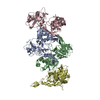
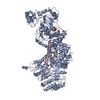
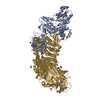

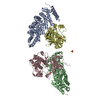


 PDBj
PDBj














